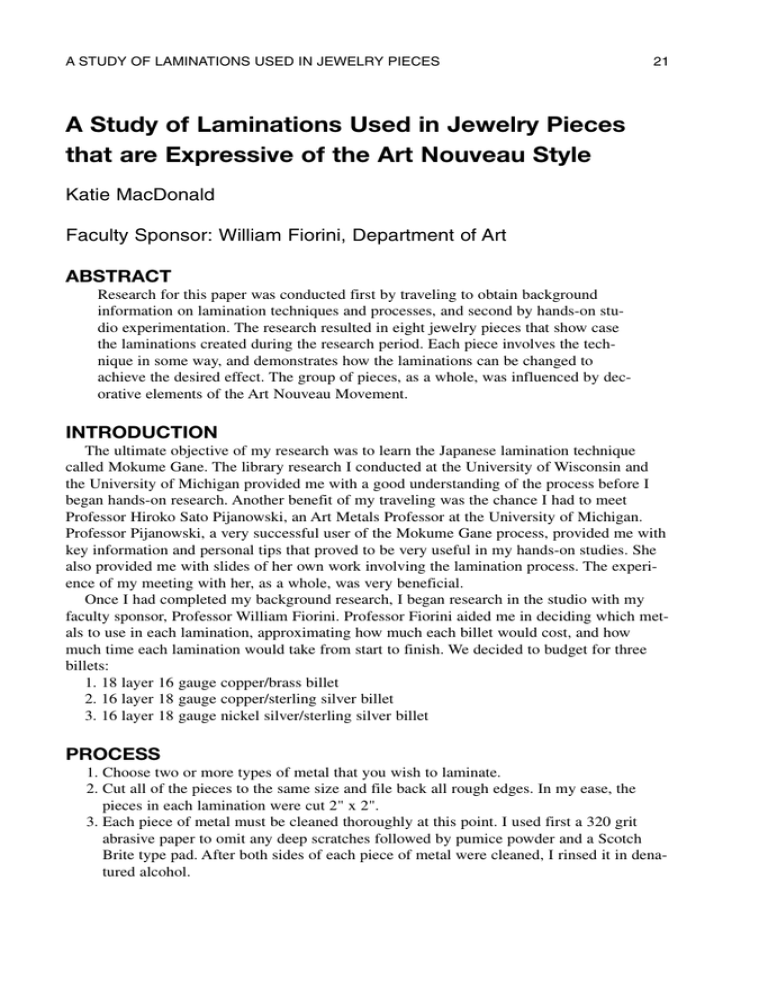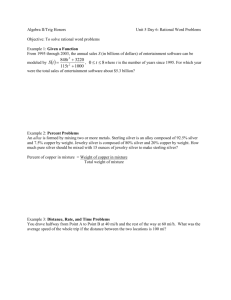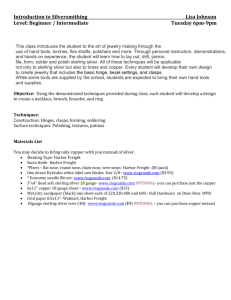A Study of Laminations Used in Jewelry Pieces Katie MacDonald
advertisement

A STUDY OF LAMINATIONS USED IN JEWELRY PIECES 21 A Study of Laminations Used in Jewelry Pieces that are Expressive of the Art Nouveau Style Katie MacDonald Faculty Sponsor: William Fiorini, Department of Art ABSTRACT Research for this paper was conducted first by traveling to obtain background information on lamination techniques and processes, and second by hands-on studio experimentation. The research resulted in eight jewelry pieces that show case the laminations created during the research period. Each piece involves the technique in some way, and demonstrates how the laminations can be changed to achieve the desired effect. The group of pieces, as a whole, was influenced by decorative elements of the Art Nouveau Movement. INTRODUCTION The ultimate objective of my research was to learn the Japanese lamination technique called Mokume Gane. The library research I conducted at the University of Wisconsin and the University of Michigan provided me with a good understanding of the process before I began hands-on research. Another benefit of my traveling was the chance I had to meet Professor Hiroko Sato Pijanowski, an Art Metals Professor at the University of Michigan. Professor Pijanowski, a very successful user of the Mokume Gane process, provided me with key information and personal tips that proved to be very useful in my hands-on studies. She also provided me with slides of her own work involving the lamination process. The experience of my meeting with her, as a whole, was very beneficial. Once I had completed my background research, I began research in the studio with my faculty sponsor, Professor William Fiorini. Professor Fiorini aided me in deciding which metals to use in each lamination, approximating how much each billet would cost, and how much time each lamination would take from start to finish. We decided to budget for three billets: 1. 18 layer 16 gauge copper/brass billet 2. 16 layer 18 gauge copper/sterling silver billet 3. 16 layer 18 gauge nickel silver/sterling silver billet PROCESS 1. Choose two or more types of metal that you wish to laminate. 2. Cut all of the pieces to the same size and file back all rough edges. In my ease, the pieces in each lamination were cut 2" x 2". 3. Each piece of metal must be cleaned thoroughly at this point. I used first a 320 grit abrasive paper to omit any deep scratches followed by pumice powder and a Scotch Brite type pad. After both sides of each piece of metal were cleaned, I rinsed it in denatured alcohol. 22 MACDONALD 4. Stack pieces of metal (in the order that you desire) between two steel clamping plates and bolt plates together. 5. The diffusion process should be done in a blacksmithing forge. The temperature of the forge should be brought up gradually. For example, the first billet I completed was copper and brass. The forge reached an estimated 1600 degrees Fahrenheit, and took about one hour to reach temperature. 6. Look for signs of diffusion, for example, visible signs of sweating and beads of metal popping out from between the layers. These are signs of diffusion. Remove plates from forge, and remove billet from between plates. 7. Forge the diffused billet down to about half of its original thickness. 8. Pattern the material by drilling or chiseling the surface. 9. Forge the billet flat after each patterning session. 10. Roll the material through the rolling mill until the desired thickness is reached. Paisley Pin; Sterling Silver, Copper/Sterling Mokume Collar #1; Steerling Silver, Copper/Sterling Mokume Collar #2; Sterling Silver, Copper/Sterling Mokume Collar #4; Sterling Silver, Copper/Brass Mokume BIOLUMINESCENT BACTERIUM ISOLATED FROM SHRIMP 23 RESULTS The result of my studio research was one successful copper/brass billet, one successful copper/sterling silver billet, and one unsuccessful nickel silver/sterling silver billet. I found nickel silver to act differently than I had thought it would in lamination. (Being a copper alloy, I thought it would act like copper in a lamination, very forgiving). The result of my miscalculation was an unsuccessful defused billet that cracked and pulled apart during the forging down process. My research also resulted in eight jewelry pieces. Each piece uses the Mokume Gane in some aspect. The following are examples from the work I fabricated: CONCLUSIONS With the completion of library research and studio research, I fell I have gained a good understanding of the basic Mokume Gane process. In the future I hope to continue studying this technique more in depth. I’d like to experiment with copper alloys such as Skakudo, Shibuichi, and Kuromi-Do. I’d also like to investigate gold, and how it behaves in a lamination. ACKNOWLEDGEMENTS I would like to thank the UW-La Crosse Undergraduate Research Committee for awarding me the money I needed to research this project. I would also like to thank my faculty sponsor, Professor William Fiorini for donating his time and knowledge to my project. 24







